You EVER HATE BEING RIGHT ABOUT HORRIBLE THINGS…???…
AND SAY TO EVERYONE…OHHH MY GOD I HATE BEING RIGHT…!!!….
WE ARE THE COCKROACHES OF THIS PLANET…!!!…ITS REALLY JUST THAT SIMPLE….
FUELED AND GUIDED BY THE EVIL TYRANNY…OF RICH FILTHY PIGS…
WE DO NOTHING BUT CONTAMINATE AND DESTROY EVERYTHING WE TOUCH…!!!…EVERYTHING….!!!…
I have always been frugal and used what I had…and reused 90% of that…
We Recycle Nothing…and that word is like a Dirty Language…To The Rich…WHY IS THAT…???…
They would rather throw the dishes away then wash them…
AS I look in My Cupboard…the simplest Fact is that 99% of our Products could Be Reused and Sold in Plastic Bags to refill the Holding Containers…I have many Plastic containers that I wash and refill with other food Products…FOR YEARS…!!!…That are suppose to be disposable…When will people SEE everything you throw in the Garbage HAS TO GO SOME WHERE…???..And if it isn’t being Recycled…THE BOTTOM LINE IS …IT WILL BE IN YOUR WATER AND FOOD EVENTUALLY AND DUMPED OVER YOUR OWN HEAD….
Imagine if you had to assume responsibility for your own Garbage…???…And couldn’t burn it…which is not getting rid of it But is Again Dumping it on your own Head when it rains…
ARE YOU FOLLOWING ME…???
I SEE THE TEARS IN GODS EYES FOR WHAT WE ARE DOING TO HIS BEAUTIFUL PLANETARIUM…
PEOPLE WAKE UP…THATS WHAT THIS IS….it is a Planet size Terrarium…Made by the HAND OF GOD…
I wonder would any of us feel any different then God if we had a nice Terrarium and someone opened it up and dumped a cup of Poison into it…and everything started to DIE…???..
OK SOMEONE JUST DELETED HALF MY POST AND HAVE TO REWRITE IT…SON OF A BITCH…!!!…
Years ago China or some country was dumping Mercury in the water ..and I thought gee I’m glad I don’t live There….LISTEN….again we are all Living in a Terrarium and it is only a Matter of time before we are ALL drinking it….OUR fresh water Supply IS ALL CONNECTED WORLD WIDE….
I always say…If Someone is Pissing in the water Up Stream Guess what you are Drinking…But to be Honest you would be Lucky if it was Just Piss…It isn’t it is Toxic Chemicals that cause Deformities in your children malnutrition,and Disease…But don’t Worry if..LOL…IF yeah thats a GOOD ONE…When You get Sick Rich Evil Pharmaciedical companies have a pill for you that will kill you a little slower with the side effects then the Toxic disease…you have in the first Place…..
ANYWAY’S’S’S….THERE’S MORE FISH IN THE SEA….NO THERE ISN’T…!!!…
Listen the OCEAN is Just Like the Land..it Has VAST DESERT WASTE LANDS…OF NOTHING…yes there is life but nothing you can live on or will sustain Humane Life….Yes Fish migrate but that is back to another living thriving Area where they have a Food supply…The ocean is nothing But Water and the Bottom That’s it….
IT’S ACTUALLY VERY SIMPLE….If you take OUT more then YOU PUT BACK …SOON the BOWL IS EMPTY…!!!…
AND GUESS WHAT…..???….THE BOWL IS EMPTY….THERE ARE NO MORE FISH LEFT IN THE OCEAN…!!! THIS IS NOT A GUESS IT IS FACT….AS WE THROW MOUNTAINS OF FOOD IN THE GARBAGE….AND YOU CAN’T FIX THIS OVER NIGHT…It takes Generations for fish to grow and repopulate….and is a Whole System and FOOD CHAIN….WE have Wiped it out….They are fished OUT..Due to Pure GREED AND WASTE….The COCKROACH EFFECT…..
SO they are predicting By 2050 the fish will be Gone…WIPED OUT…
WELL FISHED OUT….By these Massive Fisheries..Ships….
WHY IS EVERYONE WHISPERING ABOUT THIS WHEN WE SHOULD ALL BE YELLING ABOUT IT…???
AND THEIR GRAPHS…ARE HORSE SHIT….First less fish means more money to get them and we have advanced in our MASSIVE FISHING TECHNIQUES…
So this means we can catch More efficiently But there is only half as Many to catch….This is a CATASTROPHIC PROBLEM….AND MUST BE DEALT WITH IMMEDIATELY..!!!….and even then ….we are behind the eight Ball Already…with chemical Poisoning and everything else…
This OFF SET with the GRAPH I believe is Way OFF I haven’t done an Analysis but its real simple…FISH IS GOING TO SKY ROCKET IN PRICE….MORE PEOPLE….MORE FOOD…LESS FISH….MORE FUEL AND TIME EQUALS MORE MONEY….
But soon there won’t be any ANYWAY’S’S’S….
I REALLY JUST DON’T UNDERSTAND…WTF these IDIOTS that are running OUR WORLD ARE DOING…???…
ARE NONE OF OUR GOVERNMENTS CONCERNED THAT THERE IS NOT GOING TO BE ENOUGH FOOD TO FEED THE PEOPLE…???….ON OUR PLANET…???…SORRY….IN GODS WORLD….OH and that is another Statement….IN…..DO YOU UNDERSTAND…IN GODS WORLD…NOT ON…..
PEOPLE PLEASE WAKE UP….
WE ARE WIPING OUT SPECIES…THIS MAKE THIS WHOLE SITUATION EXPONENTIAL
I TRUELY SEE NO WAY TO STOP REVELATIONS…OTHER THEN GOD SENT ME A MESSENGER THAT SAID WE COULD CHANGE THIS….
MAKES ME THINK OF THE MOVIE THE TWELVE MONKEYS….
OUR WINDOW OF OPPORTUNITY..IS SLAMMING CLOSED QUICK….
AND THIS WORLD IS GOING TO BECOME ONE OF A MERCILESS STARVATIONING HELL…
PEOPLE ARE GOING TO BE KILLED FOR A PEANUT BUTTER AND JELLY SANDWICH…BELIEVE IT…!!!
Ocean warming has caused ‘sustainable’ fish stocks to drop by 4% since 1930s
How do we know ocean carbon dioxide levels are rising and pH is decreasing? By taking measurements of seawater over many years. This graph shows rising levels of carbon dioxide (CO2) in the atmosphere, rising CO2 levels in the ocean, and decreasing pH in the water off the coast of Hawaii. As carbon dioxide rises in the atmosphere, some of it dissolves into seawater, increasing the CO2 concentration there as well. As CO2 dissolves in the ocean, it reacts with water to form hydrogen ions, which drive the pH down. In combination, this process is known as ocean acidification.

OVERFISHING AND DECLINE IN FISH NUMBERS
- DECLINE IN THE NUMBER OF FISH
- Overfishing
- Causes of Overfishing
- Early History of Fishing and Overfishing
- Development of Modern Fishing
- Recent History of Fishing and Overfishing
- Rapid Growth of the Fishing Industry
- World Is Running out of Places to Catch Wild Fish, Study Finds
- Overfishing and Large Predatory Fish
- Effects of Overfishing
- Effects of Overfishing on Ocean’s Predatory Fish
- Forty Fish Species in the Mediterranean May Become Extinct
- Combating Overfishing
- Reducing the Number of Fishing Boats, Quotas and Marine Reserves
- Marine Reserves
- Catch Shares, ITQs and Combating Overfishing in Alaska and Asia
DECLINE IN THE NUMBER OF FISH

Orange_roughy_production_worldwide According to a study by Ransom Myers and Boris Worm of Dalhousie University in Halifax, Canada, published in Nature in 2003, 90 percent of the large predatory fish such as marlin, large cod, large sharks, tuna and swordfish have disappeared from the world’s oceans, Many have been snagged by long lines. There are worries that by reducing the species at the top of the food chain, entire marine ecosystems will be compromised.
The 90 percent figure was derived looking at data from Japanese fishing boats that use long lines with 2,000 or more baited hooks. In the late 1980s about 10 out of every 100 hooks snagged a fish. By the early 2002, the figure had been reduced to about 1 per 100.
Over the years the fish catch had always increased as technology improved and more fishermen took to the oceans. But then in the late 1980s catches began to decline. The fishing industry complained about proposed regulations, pointing to their surveys that showed less drastic declines.

Bluefin tuna catch Stocks of cod, haddock and herring have declined dramatically in the North Atlantic. Researchers blame drops on the levels of zooplankton (caused perhaps by global warming), overfishing and damage to coastal wetlands where young fish develop. Haddock have come back but cod have not.
There is also evidence of declines in the numbers of so-called forage fish such as herring, mackerel, anchovies and sardines. The decline is critical for both upper food chain and many poor and not so poor people around the globe that eat them.
Many fish whose numbers are declining are not even sough after as commercial fish; they are unintentionally caught on long lines of bottom-scouring trawls.
Books: Saved by the Sea: A Love Story with Fish by David Helvarg (St. Martin’s, 2010); Managed Annihilation: An Unnatural History of the Newfoundland Cod Collapse by Dean Bavington, (University of British Columbia; 2010); Four Fish: The Future of the Last Wild Food by Paul Greenberg (Penguin Press, 2010)
Overfishing

Chilean purse seine catch According to the FAO, 70 percent of the world’s marine fish stocks are fully fished, overfished, depleted or recovering. According to a United Nations report, 28 percent of the world’s fisheries are overfished or depleted. Of the 17 largest fisheries around the world, 15 are either at maximum exploitation levels or are depleting the level of their fish resource base. Joshua S. Reichert, of the Pew Charitable Trusts told National Geographic, “The oceans are suffering from a lot of things, but the one that overshadows everything else is fishing.”
Paul Greenberg wrote in National Geographic, “Some scientists, looking at the same data, see a different picture than Daniel Pauly does. Ray Hilborn, a fisheries scientist at the University of Washington, doesn’t think the situation is so dire. “Daniel is fond of showing a graph that suggests that 60 to 70 percent of the world’s fish stocks are overexploited or collapsed,” he says. “The FAO’s analysis and independent work I have done suggests that the number is more like 30 percent.” Increased pressure on seafood shouldn’t come as a surprise, he adds, since the goal of the global fishing industry is to fully exploit fish populations, though without damaging their long-term viability. [Source: Paul Greenberg, National Geographic, October 2010, Paul Greenberg is the author of Four Fish: The Future of the Last Wild Food ]
Fish harvests have increased from 3 million tons in 1900 to 20 million in 1950 to a peak of 85 million tons in the 1980s. The world fish catch has been declining by millions of tons a year since 1988. In addition to targeted fish, fishing boats also catch large amounts of bycatch (unwanted fish). By some estimated 25 percent of all fish caught are bycatch. Each year between 20 to 40 million tons of mostly dead fish are thrown back in.
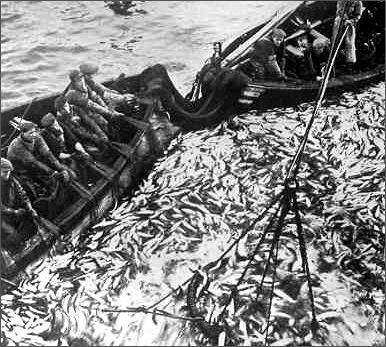
Huge catch in the 1950s Overfishing has expanded from a local problem to a global one. When one area is overfished or rules are set up to ban fishing, the large fishing boats simply move somewhere else. Often times fisheries near one country are exploited to point of collapse by fishing boats from other nations. With the depletion of fish stocks near the shores, fishermen are heading more and more out to the open sea, where 64 percent of the ocean is beyond national jurisdiction. They target seamounts, oceanic ridges and deep-ocean plateaus.
Fen Montaigne wrote in National Geographic, “Popular species such as cod have plummeted from the North Sea to Georges Bank off New England. In the Mediterranean, 12 species of shark are commercially extinct, and swordfish there, which should grow as thick as a telephone pole, are now caught as juveniles and eaten when no bigger than a baseball bat. With many Northern Hemisphere waters fished out, commercial fleets have steamed south overexploiting once teaming fishing grounds. Off West Africa, poorly regulated fleets, both local and foreign, are wiping out fish stocks from the productive waters off of the continental shelf, depriving subsistence fishermen in Senegal, Ghana, Guinea, Angola and other countries of their families’ main source of protein. In Asia, so many boats have fished the waters of the Gulf of Thailand and the Java Sea that stocks are close to exhaustion.”
Causes of Overfishing
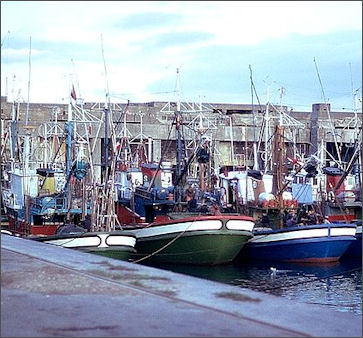
Purse seiners The problem of overfishing is being fueled by an increase in demand for fish that in turn is fueled by increased affluence (more people can afford fish as they become richer) and people eating fish for health reasons. Almost a billion people rely on fish for protein.
Fish that not so long ago hardly anybody wanted except Japan now are in high demand and cooperatives and trading companies in a number of countries are competing to acquire them, driving up their price. Higher prices create more incentives for fishermen to catch fish. Improved fishing technology and industrial-size fishing operations have dramatically increased fish catches (See Fishing).
The biggest consumers of herring, mackerel, anchovies and sardines are agriculture and aquiculture for feed for farmed fish and protein sources for pigs and cattle. Aquiculture alone consumes 53 percent of the world’s’s fish meal and 87 percent of its fish oil. On top of everything else this method is very inefficient. Approximately three kilograms of foraged fish goes into making one kilogram of farmed salmon. For cod the ratio is 5 to 1; for bluefin tuna it is 20 to 1, John Vlipe, a marine biologist at the University of Victoria in British Columbia told the New York Times.
Some see the trend in sinister terms. Describing the message of the film End of the Line , a documentary praised as theInconvenient Truth of the oceans, Frank Pope wrote in the Times of London, “Bigger, more powerful and more plentiful trawlers scrape clean every accessible patch of seabed. Companies out to please their shareholders fish only for immediate profit, exploiting every loophole to continue. Politicians paralyzed by fear, of angering the fishermen, are made complicit.”
Poor regulation and monitoring are serious problems. Fishing boats routinely report false data on their catches. Japanese, Korean, Chinese, Taiwanese, Russian and Spanish vessels have all been involved in overfishing.
Despite plummeting fish stocks overfishing is accelerating around the globe, encouraged in part by $30 billion in annual subsidies for fishing boats, fuel and other assistance, with the biggest subsidies found in Asia and Europe.
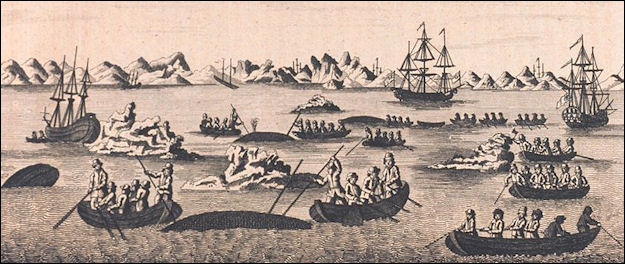
whaling in the 18th century
Early History of Fishing and Overfishing
Elizabeth Kolbert wrote in The New Yorker, “In an effort to figure out what ocean life was like before the modern era, marine scientists have, in the past few decades, cored through seafloor sediments, measured the size of fish bones tossed out at ancient banquets, and combed through the logs of early explorers. As Callum Roberts reports in “The Unnatural History of the Sea” (2007), the work suggests that humans have been wreaking havoc in the oceans for centuries.” [Source: Elizabeth Kolbert, The New Yorker, August 2, 2010]
Before the 11th century in Europe and England most fishing was done in freshwater lakes and rivers. Archeologists analyzing discarded fish bones going back 14 centuries observed freshwater fish became scarcer over time and concluded that mill dams began blocking salmon from swimming upstream in the 1100s.
Europeans began eating more fish from the sea in the Middle Ages starting around the 11th century. There were several reason for this. Fishing technology had improved and vessels were made more seaworthy. The quality and quantity of freshwater fish was declining as a result of overfishing and “deteriorating freshwater” tainted by pollution and sewage.
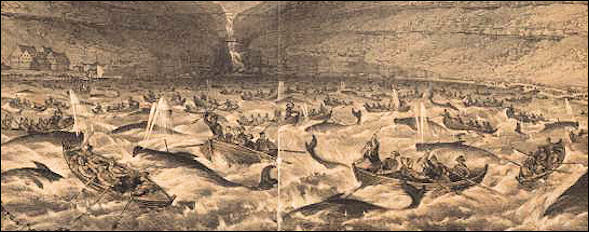
whaling in 1854
As methods for preserving and transporting fish improved, catches grew larger. As coastal fishing areas became depleted and saltwater fish became smaller and smaller fishermen began venturing further and further away from home and further out to sea.
The Age of Exploration not only opened up new continent for colonization and exploitation it also expanded the world and its oceans and opened the way for the exploitation it marine life. Many animals on both land and sea were killed for provisions. Some places were overfished hundreds of years of ago. Whales and seals were the first forms of marine life to be slaughtered to the edge of extinction.
Summing all this up, Kolbert wrote in The New Yorker, “Consider the example of Britain. Archeological deposits show that around the year 1000 Europe’s freshwater fisheries were already in decline, perhaps owing to overfishing or perhaps to the erection of dams and mills that impeded river flows. To make a living, British fishermen set out to sea. Initially, the marine catch appears to have been bountiful; analysis of what might be described as eleventh-century garbage shows that people in what is now Scotland dined on four-foot-long cod and five-foot-long pollack. But gradually local stocks were fished down, and by the fifteenth century British ships were venturing as far away as Norway and Iceland. (The Danes, who claimed Iceland for themselves, complained that the English were setting up entire villages on the island, “putting up tents, digging ditches, working away.”) When, in the early sixteenth century, British fishermen turned their attention to the newly discovered fisheries off Newfoundland, they encountered, in the words of one early settler, “Cods so thicke by the shoare that we heardlie have been able to row a Boate through them,” and the cycle began all over again.
Development of Modern Fishing

Discharging fish by traveling buckets Conspicuously wasteful and destructive fishing methods grew and became widespread along with steam-powered fishing ship, which were developed in the 1870s. Many of these employed trawl nets, which were invented in the 14th century, and dragged up everything that got in their way, even before steam power became widely used, Callum Roberts wrote in The Unnatural History of the Sea “fishers complained that the trawlers were wiping out fish stocks, especially by the destruction of fish spawn and immature fish,” that “the trawls cleared the bottom and ruined their bait beds, that “crab populations were imperiled by soft crabs being crushed when shedding their shells” and that “the trawl broke up and dispersed schools of fish, driving them away.”
One of the great advancements in fish production was salting herrings directly as it came from the sea, reducing the time-consuming drying stage and reducing the potential for spoilage from exposure to air. The fact that fish can be easily frozen and stored is one of the primary reasons it such a big global industry today.
Elizabeth Kolbert wrote in The New Yorker, “The Great International Fisheries Exhibition, which took place in London in 1883, was a celebration of all things piscatorial. More than two thousand exhibitors from around the world displayed herring nets and salmon ladders, trout rods and eel spears, life buoys and lamprey baskets. Awards—dozens of them were bestowed—included twenty pounds sterling for the best collection of smoked fish, twenty-five pounds for the best model of a sailing trawler, and ten pounds for the “best Apparatus for, or Method of, protecting Young Brood and Oysters against Dog Whelks and other natural enemies.”
Thomas Huxley, who is now mostly remembered for being an early supporter of Charles Darwin, was at the time the president of Britain’s Royal Society, and he delivered the exhibition’s opening address. As his topic, Huxley chose the question “Are fisheries exhaustible? That is to say, can all the fish which naturally inhabit a given area be extirpated by the agency of man?” The answer, Huxley decided, was a qualified no. Although people might be able to wipe out the salmon in a certain stream by throwing a net across it “in such a manner as to catch every salmon that tries to go up and every smolt that tries to go down,” conditions in the ocean were altogether different.

Loading salmon “Probably all the great sea fisheries are inexhaustible; that is to say that nothing we do seriously affects the number of the fish,” Huxley declared. To the extent that there was a problem with the fishing industry, it was due to its “relative backwardness.” Fishing, Huxley said, had failed “to keep pace with the rapid improvement of almost every other branch of industrial occupation in modern times” and still lagged “very far behind scientific agriculture . . . as to the application of machinery.”
Huxley’s views dominated thinking about fisheries for most of the next century. In 1955, Francis Minot, the director of the Marine and Fisheries Engineering Research Institute, in Woods Hole, Massachusetts, co-wrote a book titled “The Inexhaustible Sea.” As yet, he observed, “we do not know the ocean well enough. Much must still be learned. Nevertheless, we are already beginning to understand that what it has to offer extends beyond the limits of our imagination.” In 1964, the annual global catch totalled around fifty million tons; a U.S. Interior Department report from that year predicted that it could be “increased at least tenfold without endangering aquatic stocks.” Three years later, the department revised its estimate; the catch could be increased not by a factor of ten but by a factor of forty, to two billion tons a year. This, it noted, would be enough to feed the world’s population ten times over. Michael L. Weber observes, in “From Abundance to Scarcity” (2002), that as recently as the nineteen-nineties U.S. policy was predicated “on the belief that the ocean’s productivity was almost limitless.”
In the meantime, “machinery” beyond Huxley’s wildest imagining was being developed. Purse seines were introduced in the nineteen-thirties. These giant nets can be played out around entire schools of fish, then gathered up with drawstrings, like huge laundry bags. Factory freezer trawlers, developed after the Second World War, grew to be so gargantuan that they amounted to, in effect, seafaring towns. In the nineteen-fifties, many fleets added echo-sounding sonar, which can detect fish schools long before they surface. Today, specially designed buoys known as “fish aggregating devices,” or FADs, are deployed to attract species like yellowfin tuna and blue marlin. So-called “smart” FADs come equipped with sonar and G.P.S., so operators can detect from afar whether they are, in fact, surrounded by fish.
Recent History of Fishing and Overfishing
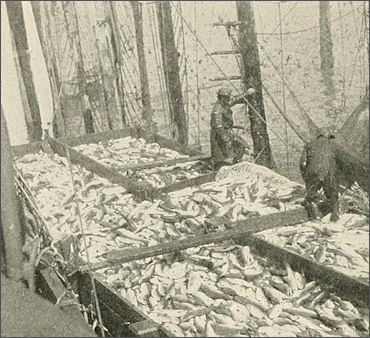
Scow load of salmon in Alaska Rachel Carson, the author the 1960s book Silent Spring , regarded by some as the founder of the environmental movement. Elizabeth Kolbert wrote in The New Yorker in 1943 she — was a young biologist working for the U.S. Fish and Wildlife Service when she wrote a booklet titled “Food from the Sea.” The point of the boosterish guide was to convince American consumers of the delectableness of fish like the wolffish, an enormous creature with a bulbous head, big teeth, and an eel-like body. Wolffish is “one of New England’s underexploited fishes, a condition that will be corrected when housewives discover its excellence,” Carson wrote. Apparently, she was so persuasive—and bottom trawling so wrecked its habitat—that the wolffish is now considered a threatened species. [Source: Elizabeth Kolbert, The New Yorker, August 2, 2010]
“In the late nineteen-eighties, the total world catch topped out at around eighty-five million tons, which is to say, roughly 1.9 billion tons short of the Interior Department’s most lunatic estimate. This milestone—the point of what might be called “peak fish”—was passed without anyone’s quite realizing it, owing to inflated catch figures from the Chinese. (These fishy figures were later exposed as politically motivated fabrications.) For the past two decades, the global catch has been steadily declining. It is estimated that the total take is dropping by around five hundred thousand tons a year.
Meanwhile, as the size of the catch has fallen, so, too, has the size of the creatures being caught. This phenomenon, which has become known as “fishing down the food web,” was first identified by Daniel Pauly, a fisheries biologist at the University of British Columbia. In “Five Easy Pieces: How Fishing Impacts Marine Ecosystems” (Island Press; $50), Pauly follows this trend to its logical—or, if you prefer, illogical—conclusion. Eventually, all that will be left in the oceans are organisms that people won’t, or can’t, consume, like sea slugs and toxic algae. It’s been argued that humans have become such a dominant force on the planet that we’ve ushered in a new geological epoch. Pauly proposes that this new epoch be called the Myxocene, from the Greek muxa, meaning “slime.”
Sportfish photographs provide a graphic illustration of overfishing. Photos from the 1950s and 60s from places like Key West, Florida show sports fishermen with huge groupers and sharks. By the 1980s they were catching only a few groupers and more jacks. Today the primary catch is small snapper, fish that formally wouldn’t have been honored with photographs. Researchers have also combed through old newspaper accounts, ship’s logs, cannery records and even old restaurant menus to glean information on which menu items were costly, and thus scarce, to get some idea of fishing patterns in the past.
Rapid Growth of the Fishing Industry

Alaska Ranger fighing factory ship Fishing fleets are growing in size and sophistication, University of Tasmania scientist Reg Watson told the Washington Post . “Humans have always fished,” he said. “We are just much much better at it now.” Examining 2006 catch results, his team found that 76 million tons of commercial seafood were hauled in – which he said equates to 7 trillion individual fish. [Source: Marc Kaufman, Washington Post, February 20, 2011]
Watson said fishing activity has been growing quickly over the past several decades, with increasingly more energy and effort exerted to bring in equal or smaller catches. Nations also are paying substantial subsidies to their fishermen, he said, especially in East Asia. “It looks like we are fishing harder for the same or less result and this has to tell us something about the oceans’ health,” he said. “We may in fact have hit peak fish at the same time we are hitting peak oil.”
Villy Christensen of University of British Columbia’s Fisheries Centre told the Washington Post, Oceans are increasingly being treated like farms, but the effort cannot be successful on a large scale. Intensive farming on land requires antibiotic treatments and pesticides to make up for the loss of a balanced ecosystem. In aquaculture, the same is true, and raising salmon or tilapia also requires importing tons of fish meal and fish oil from smaller species.
World Is Running out of Places to Catch Wild Fish, Study Finds
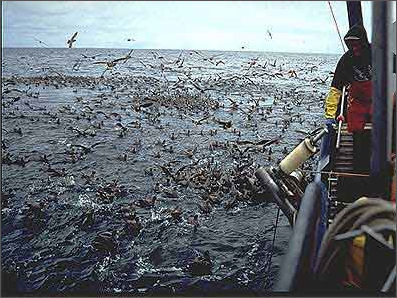
longliners Paul Greenberg wrote in National Geographic, “Humanity’s demand for seafood has now driven fishing fleets into every virgin fishing ground in the world. There are no new grounds left to exploit. But even this isn’t enough. An unprecedented buildup of fishing capacity threatens to outstrip seafood supplies in all fishing grounds, old and new. A report by the World Bank and the Food and Agriculture Organization (FAO) of the United Nations recently concluded that the ocean doesn’t have nearly enough fish left to support the current onslaught. Indeed, the report suggests that even if we had half as many boats, hooks, and nets as we do now, we would still end up catching too many fish. [Source: Paul Greenberg, National Geographic, October 2010]
Juliet Eilperin wrote in the Washington Post: “Global fisheries have expanded so rapidly over the past half-century that the world is running out of places to catch wild fish, according to a study conducted by researchers in Canada, the United States and Australia. The findings, published in the online journal PLoS ONE, are the first to examine how marine fisheries have expanded over time. Looking at fleets’ movements between 1950 and 2005, the five researchers charted how fishing has been expanding southward into less exploited seas at roughly one degree latitude each year to compensate for the fact that humans have depleted fish stocks closer to shore in the Northern Hemisphere. [Source: Juliet Eilperin, Washington Post, December 2, 2010]
During that same period the world’s fish catch increased fivefold from 19 million metric tons in 1950 to a peak of 90 million in the late 1980s, before declining to 87 million tons in 2005. It was 79.5 million tons in 2008, according to the U.N. Food and Agriculture Organization, the most recent year for which figures are available.
Daniel Pauly, a co-author who serves as principal investigator of the Sea Around Us Project at the University of British Columbia Fisheries Centre, said the global seafood catch is dropping “because there’s essentially nowhere to go.” The fact that fish catches rose for so many decades “looks like sustainability but it is actually expansion driven. That is frightening, because the accounting is coming now.” The authors – including lead author Wilf Swartz, who is a doctoral student at the university, and National Geographic Society ocean fellow Enric Sala – write that this relentless pursuit for seafood has left “only unproductive waters of high seas, and relatively inaccessible waters in the Arctic and Antarctic as the last remaining ‘frontiers.’ ” “The focus should move from looking for something new to looking at what we have and making the most sustainable use out of it,” Swartz said in an interview.
Overfishing and Large Predatory Fish
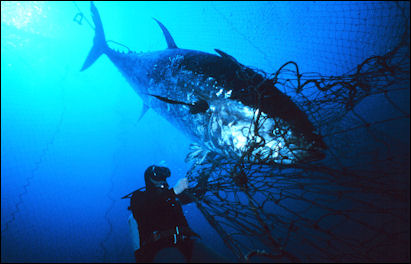
ensnared tuna Analysis of more than 200 ecological systems studied since 1880 by a team led by Villy Christensen of University of British Columbia’s Fisheries Centre shows that a decrease of than 54 percent in the catch of large predator fish has taken place over the past 40 years.
“It’s a question of how many people are fishing, how they are fishing, and where they are fishing,” Christensen said. A majority of the catch, and now of the decline, involves East Asia, which has witnessed dramatic overall economic growth.
Effects of Overfishing
Scientists warn that declines in large fish species could cause many fishermen to lose their jobs, deprive the world of an important source or protein and nutrition and throw marine ecosystems out of balance. In some cases if one large predator is overfished other large predators step in to fill in the gap but then these species too are overfished and before long populations of all large predators are decimated either by overfishing or accidental catching in efforts to catch large valuable species.
The decline of the size of fish also means that the fish are not living as long as they used to. This phenomena, known to biologists as “juvenescence,” may inhibit the ability of these species to reproduce and survive in significant numbers in the future.
The disappearance of large predators could throw entire marine ecosystem out of whack in ways that people had not anticipated. Fish are and the food chain they maintain are essential for eating up algae and keeping microbes in check. According to a report by the International Programme on the State of the Ocean (IPSO) the harvesting up to 90 percent of some species of big fish and sharks, meanwhile, has hugely disrupted food chains throughout the ocean, leading to explosive and imbalanced growth of algae, jellyfish and other “opportunistic” flora and fauna.
The result of overfishing for fishermen is that they work harder and longer hours and sail farther to catch fewer fish. Millions of poor are deprived of an important protein source.
Effects of Overfishing on Ocean’s Predatory Fish
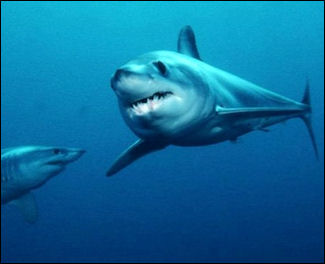
mako shark Marc Kaufman wrote in the Washington Post, “Over the past 100 years, some two-thirds of the large predator fish in the ocean have been caught and consumed by humans, and in the decades ahead the rest are likely to perish, too. In their place, small fish such as sardines and anchovies are flourishing in the absence of the tuna, grouper and cod that traditionally feed on them, creating an ecological imbalance that experts say will forever change the oceans.”Source: Marc Kaufman, Washington Post, February 20, 2011]
“Think of it like the Serengeti, with lions and the antelopes they feed on,”Villy Christensen of University of British Columbia’s Fisheries Centre told the Washington Post. “When all the lions are gone, there will be antelopes everywhere. Our oceans are losing their lions and pretty soon will have nothing but antelopes.” On the cause, Christensen said, “It’s a question of how many people are fishing, how they are fishing, and where they are fishing.” A majority of the catch, and now of the decline, involves East Asia, which has witnessed dramatic overall economic growth.
This grim reckoning was presented at the American Association for the Advancement of Science’s annual meeting Friday during a panel that asked the question: “2050: Will there be fish in the ocean?” The panel predicted that while there would be fish decades from now, they will be primarily the smaller varieties currently used as fish oil, fish meal for farmed fish and only infrequently as fish for humans. People, the experts said, will have to develop a taste for anchovies, capelins and other smaller species.
In describing the likely explosion of small fish, Christensen’s team differed with a 2006 report in the journal Science that warned of an ocean without fish for humans by mid-century. But they say that absent predators, the fisheries will be out of balance and more subject to mass die-offs from disease and from boom-and-bust cycles that, over time, can lead to algae or bacteria blooms that take the oxygen out of the waters and make them uninhabitable.
Forty Fish Species in the Mediterranean May Become Extinct
AP reported in April 2011, “A new study suggests that more than 40 fish species in the Mediterranean could vanish in the next few years. The study by the International Union for Conservation of Nature (IUCN) says almost half of the species of sharks and rays in the Mediterranean and at least 12 species of bony fish are threatened with extinction due to overfishing, pollution and the loss of habitat.” [Source: John Heilrpin, AP, April 18, 2011]
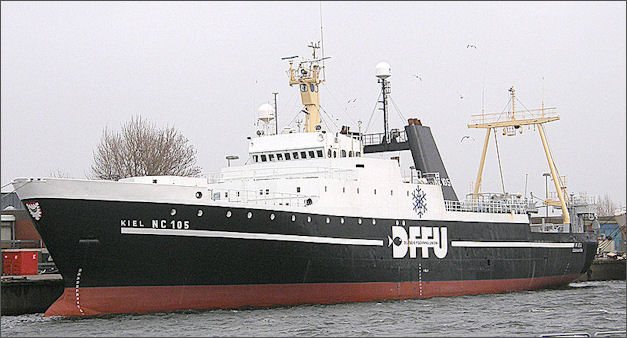
Factory fishing ship
Commercial catches of bluefin tuna, sea bass, hake and dusky grouper are particularly threatened, said the study by the Swiss-based IUCN, an environmental network of 1,000 groups in 160 nations. “The Mediterranean and eastern Atlantic population of the Atlantic bluefin tuna is of particular concern,” said Kent Carpenter, IUCN’s global marine species assessment coordinator. He cited a steep drop in the giant fish’s reproductive capacity due to four decades of intensive overfishing. Japanese diners consume 80 percent of the Atlantic and Pacific bluefins caught and the two tuna species are especially prized by sushi lovers.
The U.N. Food and Agriculture Organization says fish stocks continue to dwindle globally despite increasing efforts to regulate catches and stop overfishing. Fishing in the Mediterranean is regulated by U.N. treaties, the European Union and separate laws among the 21 nations that border the sea. The IUCN study, which began in 2007 and included 25 marine scientists, is the first time the group has tried to assess native marine fish species in an entire sea.
The study blames the use of highly effective trawlers and driftnets for the incidental capture and killing of hundreds of marine animals with no commercial value. But it also concluded there’s not enough information to properly assess almost one-third of the Mediterranean’s fish. “Even though marine resources in the Mediterranean Sea have been exploited for thousands of years and are relatively well studied, the data deficient group may in fact include a large proportion of threatened fishes,” the study said, calling for more research.
Combating Overfishing
A number of international agreements on oceans and fisheries have been signed. At the Johannesburg Earth Summit in 2003, for example, participants agreed to aim to restore fish stocks to sustainable levels by 2015. Many large fishing boats are required to take a biologist along to make sure they are respecting international fishing laws. Commercial fishers have resisted quota and moratoriums. Many of agreements are difficult to enforce and lack penalties that could truly serve as deterrents.

Russian factory fishing ship
Many scientists and conservationists says that several urgent things have to be done if the world’s oceanic fish are to stand a chance of surviving in healthy numbers. They include: 1) the ocean needs to be seen as an ecosystem, with all of its components addressed, and not seen as an endless supplier of marine life for modern technology to exploit. 2) The management councils that oversees fisheries, need to include more scientists and conservationists among their members not just representatives of the fishing industry. 3) Tough quotas have to be set and enforced. 4) And perhaps the most important thing of all is that the number of fishing boats has to be limited.
In “Four Fish,” Paul Greenberg argues that the salvation of wild fish lies in farmed ones, though not in the kind you’ll find on ice at Stop & Shop. (Today, most farmed fish are fed on wild-caught fish, a practice that only exacerbates the problem.) Greenberg is a believer in what’s sometimes called “smart aquaculture,” and thinks we should be eating species like Pangasius hypophthalmus, commonly known as tra. Tra happily feed on human waste and were originally kept in Southeast Asia to dispose of the contents of outhouses. [Source: Elizabeth Kolbert, The New Yorker, August 2, 2010]
Paul Greenberg wrote in National Geographic, “What Pauly and other conservation biologists now believe is that suggestions must be transformed into obligations. If treaties can establish seafood-consumption targets for every nation, they argue, citizens could hold their governments responsible for meeting those targets. Comparable strategies have worked to great effect in terrestrial ecosystems, for trade items such as furs or ivory. The ocean deserves a similar effort, they say.
Restoration plans have been adopted for troubled fish stocks and some fisheries are rebounding. Fish stocks are often resilient and come back. But not always. Some fish such as the Atlantic cod either are very slow in coming back or won’t come back after they have been over fished.
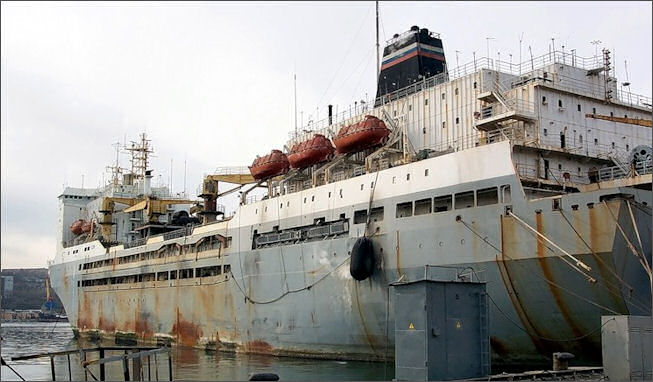
Russian factory fishing ship
Overfished areas can rebound in a relatively short period of time. In 1994, after fisheries collapsed in the Georges Bank in the Gulf of Maine, groundfish fishing and dragging for scalloped was banned in three areas that together encompassed more than 17,200 square kilometers. Within five years haddock and flounder stocks had rebounded and scallops were bigger and became nine to 14 times more dense than in fished areas. Places where cod and swordfish were once king fishermen they can make a living catching snow crabs and lobster, whose populations have increased.
Reducing the Number of Fishing Boats, Quotas and Marine Reserves
Jacqueline Alder from the U.N. Environment Program suggested that the number of fishing boats and days they fish have to be restricted. “If we can do this immediately, we will see a decline in fish catches. However, that will give an opportunity for the fish stocks to rebuild and expand their populations,” she said. Daniel Pauly, a fisheries scientist at the University of British Columbia, suggests reducing the world’s fishing fleets by 50 percent, establishing large no-catch zones, limiting the use of wild fish as feed in fish-farming. In no-catch-zones, Enric Sala, a National Geographic fellow, “Barely one percent of the ocean is now protected, compared with 12 percent of the land,” Enric Sala adds, “and only a fraction of that is fully protected.” Unfortunately, the seafood industry and some national government have blocked efforts to make reforms.
On the issue of limiting the number of fishing boats and keeping a close watch on what fishermen catch, governments can help out by buying out fishing boats and licences, creating economic incentives for some to quit fishing, and adopting better monitoring procedures. But even if measures are widely adopted by regulated vessels there are large numbers of illegal, unregulated and unreported (IUU) vessels out there that skirt the rules and answer to no one.
Improvements in fishing methods have reduced bycatch by up to 60 percent and dramatically reduced the number of endangered birds such as albatrosses that are caught in fishing lines. Measures such as closing seasons, closing areas or limiting access often do not work because fishing vessels are so efficient so they can take in the amount of fish normally taken in by several vessels.

Alaska Ranger side layout
Some have proposed that huge swaths of the sea be set aside as so-called “marine protected areas,” or M.P.A.s, where most commercial activity would be prohibited.
Marine Reserves
Setting up marine reserves is seen as major means of saving the world’s oceans. In 2009, in the closing weeks of his term, U.S. President George W. Bush, who was not well known for his environmental record, established the largest marine conservation area in U.S. history when he declared a 505,800 kilometer protected area in Pacific Ocean that included the Mariana Trench , and areas around islands in Marianas, Samoa and near the equator. In 2006, he also created the largest marine reserve in the world— the Hawaiian Islands Marine National Monument, a 138,000-square-mile reserve in an area of unspoiled reefs and shoals neat the Hawaiian Islands. The area covers an area larger than all the national parks in the United States combined.
Scientists have called for the creation of a network of marine parks and protecting more ocean areas. Only 0.5 percent of the oceans are protected, compared to about 12 percent of the Earth’s land area. Most protected areas are close to shore such as the Great Barrier Reef, waters around the Galapagos Islands or places in the Mediterranean.
Catch Shares, ITQs and Combating Overfishing in Alaska and Asia
Michael Weber, the author of “From Abundance to Scarcity,” is encouraged by the introduction of new regulatory mechanisms such as “individual transferable quotas,” or I.T.Q.s. The idea behind I.T.Q’s is that if fishermen are granted a marketable stake in the catch they will have a greater economic interest in preserving it. [Source: Elizabeth Kolbert, The New Yorker, August 2, 2010]
Many believe the solution to the overfishing problem is establishing overall catch quotas and allow people to buy and sell their fishing rights. A regulatory scheme known as “catch shares” allows fishermen to own shares in a fishery—that is, the right to catch a certain percentage of a scientifically determined sustainable harvest. Fishermen can buy or sell shares, but the number of fish caught in a given year is fixed. The method has worked well with lobsters in Australia and made lobstermen there very rich. It has also worked very well in Alaska. A study published in Science estimated that if catch shares were put in place in 1970 only 9 percent of the world’s fisheries would have collapsed rather than 27 percent as had occurred by 2003.
Alaska’s fishing industry regulation scheme has become a model for sustainable fishing. Each year during the salmon spawning human fish counters take up positions along the major salmon rivers, spotter planes track the migration of the fish, patrols ward of aggressive bears and the first hint that there is a decline in number of fish the entire fishing season is put in hold and fishermen are ordered to pull in their nets.
Fishermen are eager to cooperate. The system was put in place after Alaskans learned their lesson about killing their goose with the golden egg when salmon fisheries collapse as a result of overfishing in the 1950s.
For the overfishing problem to be really be addressed the sustainability movement has to catch on Asia. More than two thirds of the world’s seafood is consumed in China, Japan and other parts of Asia and boats from China, Japan, South Korea, Taiwan and Russia pull in some of the the largest catches, much of it undocumented.
Replacing wild fish altogether would not be easy, Gibbons noted. Ray Hilborn, a University of Washington professor of aquatic and fishery sciences, recently estimated that switching from wild fish to an equivalent amount of animal protein from pigs, cattle and chickens could take land resources equal to 22 times the existing rainforest. [Source: Juliet Eilperin, Washington Post, December 2, 2010]
Image Sources: Wikimedia Commons, National Oceanic and Atmospheric Administration (NOAA)
Text Sources: New York Times, Washington Post, Los Angeles Times, Times of London, Yomiuri Shimbun, The Guardian, National Geographic, The New Yorker, Time, Newsweek, Reuters, AP, Lonely Planet Guides, Compton’s Encyclopedia and various books and other publications.
© 2008 Jeffrey Hays
Last updated January 2012

